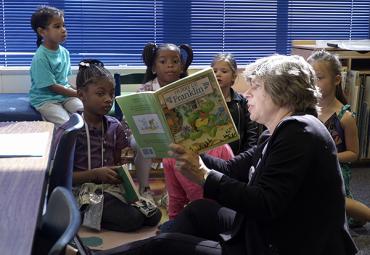School inequity & disinvestment rob children of their future
As I write this, President Trump and his political party, who control every branch of the federal government, are toying with the health of 9 million kids and the fate of 800,000 Dreamers in their erratic negotiations over a government shutdown—putting those young people, our military and every American at risk.
What does it say about our society—and our humanity—that children are so rarely a priority in the United States? We say that education is crucial for opportunity and that public education is foundational to our democracy. But do we really mean it? A recent report from the U.S. Commission on Civil Rights says no.
The report details how profoundly inequitable funding of K-12 education is for low-income students and students of color. The highest-poverty school districts in the United States receive an average of $1,200 less per pupil than the lowest-poverty districts. Districts serving the largest numbers of students of color receive about $2,000 less per pupil than districts that serve the fewest students of color. And many students of color experience “double segregation”—segregation by both race/ethnicity and concentrated poverty.
That’s not all. Twenty-nine states provide less overall state funding for public education than they did in 2008, before the Great Recession took hold. And in 19 states, local government funding for education fell during the same period, compounding the harm.
It is a stain on our nation that so many low-income children and children of color attend schools in deplorable conditions, with large class sizes and without adequate teaching and learning essentials like textbooks and technology. Schools serving large numbers of children from low-income families often do not have a school nurse, counselor or librarian. Every child deserves a good education in a safe and welcoming environment. But inequitable school funding and outright discrimination deprive huge numbers of young people of this fundamental right.
There are still people who say that money doesn’t matter in education. Of course money matters. It matters in Baltimore, where students and staff shivered this winter in classrooms that were barely warmer than the subfreezing temperatures outside. It matters in Scarsdale, N.Y., where local tax dollars fund a rich array of art and Advanced Placement classes, STEM programs, and language instruction in French, Latin, Mandarin and Spanish—taxes that will no longer be deductible under the new Republican tax plan, which will squeeze public schools and services even in affluent communities.
Money matters to public school parents who, on a recent national survey conducted for the AFT, cited inadequate funding as the most important problem facing public schools today. The survey found that parents strongly support greater investments in neighborhood public schools, with particular emphasis on expanding career and technical programs, reducing class sizes, supporting struggling schools, offering art and music, and providing health and nutrition services. They also worry about the shifting of resources from local public schools to charters and vouchers. Despite these concerns, three-fourths of parents say that the public schools their children attend provide them with an excellent or good education.
It’s not just state fiscal policies that are hurting education; federal fiscal policies are veering in the wrong direction too. President Trump has proposed cutting $9.2 billion, or 13.5 percent, from K-12 and higher education in the budget being debated on Capitol Hill right now. And the Republican tax plan, which restricts taxpayers’ ability to deduct their state and local taxes, makes it harder for states and communities to fund public schools and other essential services. They’ve created a zero-sum game with stark choices: Public schools could be pitted against bridge repairs, healthcare against low-income housing.
Public school teachers and staff work heroically to overcome society’s uneven allocation of education opportunities, yet they (and their unions) often are blamed for the consequences of the failure to invest in schools and in children. A recent survey by the AFT and the Badass Teachers Association found that inadequate resources, teachers’ lack of influence over decisions affecting teaching and learning, and the blaming and shaming of teachers, have left them twice as stressed as people in other professions.
Studies show that large permanent increases in school spending—often as a result of lawsuits challenging inequitable funding—improved long-term outcomes for students, such as adult wages; medium-term outcomes, such as high school completion rates; and short-term outcomes, such as SAT and other standardized test scores. Adequate education funding is particularly crucial for the half of public school students in America who live in poverty. This is a moral and economic imperative.
The U.S. Commission on Civil Rights calls on the federal government to take action to address inequitable funding in our nation’s public schools. We couldn’t agree more. As Martin Luther King Jr. wrote in his “Letter from Birmingham Jail,“ “justice too long delayed is justice denied.”

